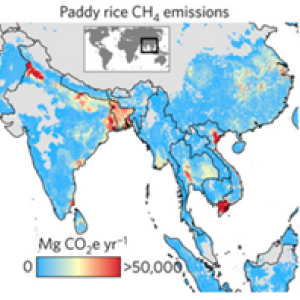
This paper examines high-resolution, crop-specific GHG emissions and GHG intensity estimates which are derived using a method that couples biophysical models with novel 5-arc-minute resolution data.
Of the practices investigated, peatland drainage is found to have the most disproportionate impact on emissions, accounting for 32% of cropland emissions while only producing 1.1% of crop kilocalories. It is argued that mitigation policies should be targeted specifically at locations where crops have both high emissions and high intensities.
The study uses spatially explicit global GHG emissions accounting to investigate global GHG fluxes from croplands (circa 2000). Specifically, the authors consider:
- CH4 emissions from paddy (flooded) rice cultivation
- CO2, N2O and CH4 flux from agricultural peat land draining,
- direct and indirect N2O emissions from synthetic nitrogen (N) fertilizer and manure application
The study finds that the total of these global cropland GHG emissions amounts to approximately 1994 TgCO2e yr-1, or 4.5% of total anthropogenic emissions. About 48% of those emissions are from flooded rice, 32% from peatland cultivation and 20% from N fertiliser application. The top ten emitting crop varieties are found to account for 75% of the cropland emissions, with rice providing the most significant contribution. Emissions are found to be concentrated in Asia, with China, Indonesia and India combining to produce 51% of the total cropland emissions.
Since rice is a staple food for nearly half the world’s population, its high overall emissions contribution is not wholly surprising. However, it is also found to be the most GHG intensive of any of the major crops (0.63 Mg CO2e M kcal-1 production intensity). With rice consumption projected to increase dramatically over the coming years, the authors stress the need to carefully consider production techniques and the potential benefits and trade-offs of crop switching. See also this paper which we summarised which argued that the 'nutritional yield' of crops also need considering and showed that rice performs quite badly relative to other crops in its provision of important nutrients such as protein, iron and zinc.
The authors also express concern over the practice of peatland draining, which exposes carbon-dense peatland soils, and generates disproportionately large, sustained GHG emissions which are comparable, in long run, to those of deforestation. Indonesia is identified as a nation that is particularly reliant on crops grown on peat (33% of global cropland peat CO2e). The authors argue that mitigation policies should aim to eliminate the practise of peatland draining altogether.
Of the management practices considered, N fertiliser application is found to be the least GHG intensive and most malleable while also having high potential for efficiency gains. However, marginal increases in production intensity are observed when the effects of additional N fertiliser application are modelled.
The authors conclude by highlighting the utility of their data to policy makers who are trying to reconcile rapidly increasing crop demand with the need to address climate change. They propose that the spatially refined GHG emissions and intensity data can allow for the careful design of precision mitigation strategies targeted at the most GHG intensive locations. Such strategies could include farmer education through extension and outreach, corporate sustainability commitments, national food policies, and multilateral agreements.
Abstract
Stabilizing greenhouse gas (GHG) emissions from croplands as agricultural demand grows is a critical component of climate change mitigation. Emissions intensity metrics—including carbon dioxide equivalent emissions per kilocalorie produced (‘production intensity’)—can highlight regions, management practices, and crops as potential foci for mitigation. Yet the spatial and crop-wise distribution of emissions intensity has been uncertain. Here, we develop global crop-specific circa 2000 estimates of GHG emissions and GHG intensity in high spatial detail, reporting the effects of rice paddy management, peatland draining, and nitrogen (N) fertilizer on CH4, CO2 and N2O emissions. Global mean production intensity is 0.16 Mg CO2e M kcal−1, yet certain cropping practices contribute disproportionately to emissions. Peatland drainage (3.7 Mg CO2e M kcal−1)—concentrated in Europe and Indonesia—accounts for 32% of these cropland emissions despite peatlands producing just 1.1% of total crop kilocalories. Methane emissions from rice (0.58 Mg CO2e M kcal-1), a crucial food staple supplying 15% of total crop kilocalories, contribute 48% of cropland emissions, with outsized production intensity in Vietnam. In contrast, N2O emissions from N fertilizer application (0.033 Mg CO2e M kcal−1) generate only 20% of cropland emissions. We find that current total GHG emissions are largely unrelated to production intensity across crops and countries. Climate mitigation policies should therefore be directed to locations where crops have both high emissions and high intensities.
Reference
Carlson, K.M., Gerber, J.S., Mueller, N.D., Herrero, M., MacDonald, G.K., Brauman, K.A., Havlik, P., O’Connell, C.S., Johnson, J.A., Saatchi, S. & West, P.C. (2016). Greenhouse gas emissions intensity of global croplands. Nature Climate Change, 7, 63–68 (2017) DOI:10.1038/nclimate3158
Read more here.







Post a new comment »